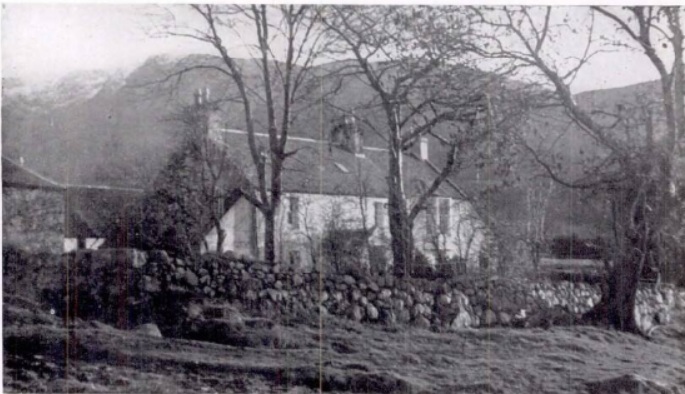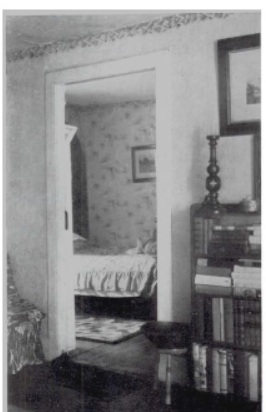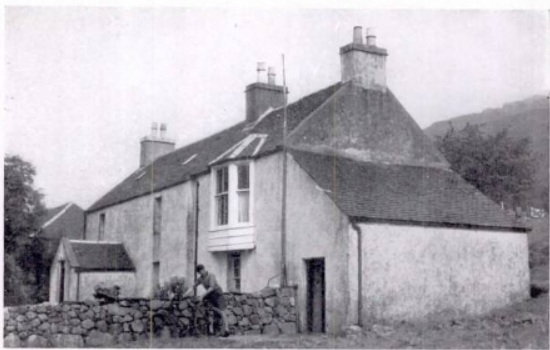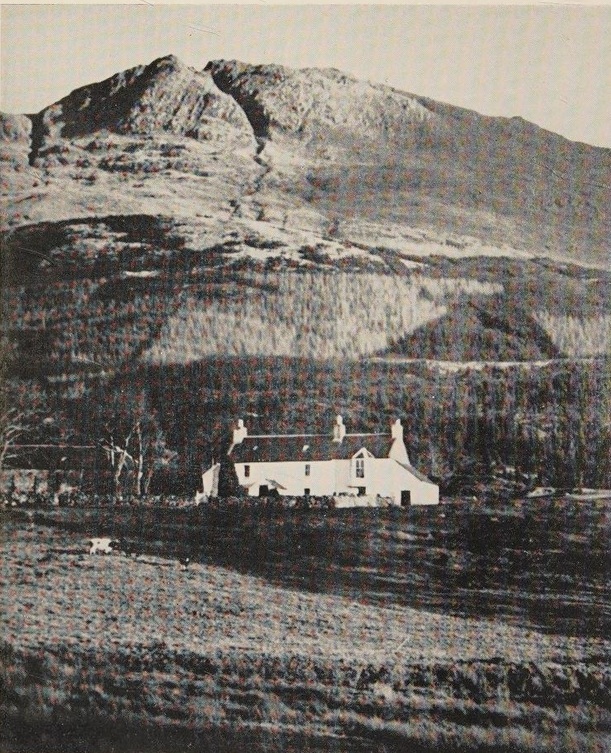The Haunted Farm-house.
Written and illustrated by Alasdair Alpin MacGregor.
Few with any appreciable knowledge of Scotland have not heard of Glen Duror, that steep and comparatively short valley running inland from the roadside at Duror of Appin to terminate in a bowl of mountain. On a rushy and nettley spot at the head of this Argyllshire glen are the ruins of the holding from which James Stewart – James of the Glen, as history denotes him – was evicted in the middle of the eighteenth century; and farther down one comes upon Acharn, the small farm of which James was tenant when the authorities arrested him on a charge of being accessory to the murder of Colin Campbell of Glenure.
On the hillside, within a few hundred yards of Acharn, stand the farm-house and steading of Achnadarroch, behind which Ben Vair rises steeply, its lower flanks thickly planted with conifers by the Forestry Commission. Indeed, the whole of Glen Duror has been planted in this wise in recent years, and now presents a thriving, prospering nursery.
The farm-house is certainly one of the oldest dwellings in the district. It is said to have been built by one of the Stewarts of Ardsheal, an ancient Appin property, the loftier parts of which are to be seen from its windows. At the time Achnadarroch was built it would have been regarded as a mansion. The old house, whitewashed and conspicuous against its background of dark-green pines, can be seen when, in passing along that inland strip of the Appin road between Kentallen Bay and Cuil Bay, one looks eastward up Glen Duror. Adjoining the house are not inconsiderable farm-steadings. Immediately behind it and invisible from the approaches lies a cottage which, in the days when Achnadarroch was extensively and profitably worked as a sheepfarm, would have been the bothy occupied by the farm-labourers and shepherds. At present the cottage is inhabited by a man and his wife, who tenant Achnadarroch, but who have sub-let the old farm-house to my friend, Seumas Stewart, to whom I shall refer hereinafter as Seumas, this being the Gaelic for James, and also the name by which he is now known in Appin – a new Seumas a’ Ghlinne, as it were: a 20th century James of the Glen.
Achnadarroch is a house of many apartments. The more spacious of these are distributed on two floors. There is a series of long narrow attic bedrooms aloft. With the exception of the Haunted Room (so called because it happens to be a little more ghosty than the rest) which opens off the dining-room, those on the ground floor are large. They are all low-ceilinged, however. The Haunted Room, which is now used as a bedroom, was once the general storeroom of the house. One cannot but notice the enormous thickness not only of Achnadarroch’s outer walls, but also of those separating its various apartments. The living-room, which was formerly the farm kitchen, is panelled in pinewood. The large square tiles covering its floor are old, and lie very unevenly. Scarcely two of them are in juxtaposition at the same level. They all tend to slope toward the fireplace. The passing of the feet of centuries has worn them hollow in places, especially in front of the fire, and at the three doorways and passages leading into and out of this quaint apartment.
The house possesses nothing in the way of gas or electric lighting: oil-lamps and candles are still the order at Achnadarroch.
At this juncture one ought to mention that Achnadarroch and the immediate neighbourhood are haunted by one to whom the Appin folks allude as the Maid of Glen Duror. The Maid is often seen in and about the house itself. She appears at the windows on the ground floor, in the adjoining farm-steading, and also in the lonelier parts of Glen Duror. A little old woman is frequently seen peering in through the lower windows. Among the commonest of her haunts out of doors are the lower slopes of Ben Vair, just behind the farm-house. Long ago, it seems, she was employed at Achnadarroch by its original Stewart owners, possibly as dairy-maid. In any case, she was often to be seen herding the Achnadarroch cattle in that part of Glen Duror now so completely planted.
Originally the Maid, as she is spoken of in the district, was a MacColl, one of a clan still fairly numerous in this neighbourhood. I am told by Mrs Cameron, who now lives at Duror Station, but once resided at Achnadarroch, that the Maid, in her present ghosty form, has always been kindly disposed towards the Appin Stewarts, and towards their followers, the MacColls. Mrs Cameron is a MacColl by birth. During her twenty years’ stay at Achnadarroch she frequently saw the grey wraith of the Maid at dusk and heard things go bump in the night.
xxx
For reasons of health, Seumas Stewart gave up his theatrical activities in London and elsewhere, and came to live at Achnadarroch in February, 1943. He was scarcely settled in when a series of curious happenings began. as the house had been void of inhabitants for some months previously, it had a very damp and musty smell. So he formed the habit of leaving open the doors of rooms and passages, in order that the place might get thoroughly aired. This became the more necessary as it is usually impracticable, during our Highland Winters of wind and driven rain, to leave the windows open for any length of time. The doors in the attics, as well as those of the rooms on the first floor, with the exception of that belonging to the small bedroom in which he himself slept, were always left open when he retired. But his rest was sometimes disturbed – nay, shattered – by their banging with great violence.
To begin with, and he quite unaware of any haunting, he would rise instantly to make investigations. Perhaps he had left open a windward window, which might have explained this terrifying and terrific banging in the night. But no! In making a tour of the old house to find that all the windows were already closed, he had to open all the doors again. These he would leave wide open when returning to his bedroom, which he sometimes barely reached before one or two doors closed once more with great emphasis. He would not bother going through the house to re-open them that night.
If wakeful, he sometimes had a little amusement by continuing to rise and open the doors whenever he heard them close. But he never had the last word in the matter, since some influence, of which he knew not, always outwitted him before dawn. Gradually he got tired of this game, as it were, and resolved to pay no heed to the doors’ antics. As yet, he had not the faintest suspicion that there may have been something occult about their behaviour.
Not long after Seumas had taken up residence at Achnadarroch he began to see, from time to time, and usually at dusk, a little old woman peering in at a corner of the window of the farm-house kitchen, which by now he had converted into his living-room. He mildly tolerated this at the outset, believing her to be an inquisitive neighbour. He did not know in the least whom she might have been because, as yet, he was acquainted with no one in the locality except the farmer and his wife who occupy the cottage behind the farm-house, and the forestry overseer and his wife, who reside in a house recently built about a hundred yards away. But the face seen at the window was not that of any of them.
Soon the old woman’s rude insistence became an annoyance. He now resorted to hurrying out to the lawn before the house, in the hope of intercepting her and perhaps of identifying her in torch-light. But he never could find anyone there. If he were really seeing an old woman, she was adept at getting out of ken very quickly, especially when one considers that quite a substantial stone wall and an inner hedge surround the lawn on three sides, and that the front of the house bounds it on the fourth. Notwithstanding, it struck him as being possible that anyone familiar with the lie of the land could easily nip over the hedge and wall and disappear where the ground slopes so steeply away from the front of the house.
It was at this stage that Seumas began to think that there was something odd about Achnadarroch. An unaccountable reluctance to enter the dining-room now seized him. Herein lay several of his packing-cases. To these he frequently had occasion to resort for various items, since he was still in process of arranging the house preparatory to inviting relatives and friends to visit him. From time to time, then, when entering the dining-room to unpack some household utensil or, perhaps, some piece of old furniture which he valued (all Stewarts, by the way, appear to be fervid collectors!) he always felt uneasy, and was relieved to get out of it again. For no apparent reason, he sensed a peculiar chill. Even when a fire burned brightly in the room, this chill came over him.
A week or two later, Seumas’s mother, sister and infant niece arrived on a prolonged visit to Achnadarroch. By this time the packing-cases had been stowed away elsewhere. The dining-room was now in order except, perhaps, that no pictures had been hung as yet. This room was set aside as a play-room for the little niece, then about three years of age. It was hoped that the child would continue to amuse herself therein with her toys, while the remainder of the household was otherwise engaged in hanging curtains, laying carpets, and so on. But the child would not remain in the room alone. “I don’t like it here!” she would say when asked why she would not stay in the nice, warm room. “But why?” her relations enquired of her. “Cause I don’t like that woman!” she would reply. Reluctantly, the child might return for a little, and then come out again to get in the way of those busily employed in putting the house into some sort of order.
After a stay of some weeks, Seumas’s mother, sister and niece departed. At night-fall a day or two later, he had occasion to visit the forestry overseer and his wife, who lived but a hundred yards away. In leaving the old farm-house by the side door, he chanced to glance along the front of the house, and was astonished to see the figure of a woman. She was standing by the window at which he previously had seen an unkent face. Although a little alarmed, he stood his ground, and, while so doing, actually saw her glide away across the lawn, and then vanish. He now felt decidedly uncomfortable at the prospect of having to return to occupy the house alone that night.
xxx
Some nights later, Seumas was seated at the table, writing a letter by the light of a brilliant incandescent oil-lamp. While he was re-reading the letter before enclosing it, his attention was diverted by the figure of an old woman passing noiselessly towards the window, whereat she stood for a moment, waving her arms as if she were trying to shoo someone away. She was clad in a long, hooded cloak, and seemed as luminous as she appeared to be impalpable. Meanwhile, the window-curtain billowed right out into the room, as though a breeze had caught it. The window, however, was closed; and there was no sound anywhere, for the night was one of unusual stillness. As the wraith vanished, Seumas recognised on it the face of the person he had seen keeking through at a corner of the window. He was much shaken. In fact, for some little time, he found himself quite unable to move. He now began to connect this visitation with the persistent opening and banging of the doors.
xxx
It was in the Summer of 1943 that Seumas and his mother and sister and brother-in-law heard three distinct bumps, followed by three even more distinct crashes, in the region of the staircase. On rushing out to discover whether anything of value had dropped, they found, in the bedroom where the little niece was asleep, that three large paper-weights, each weighing two-and-a-half pounds, had come off the window-sill, had fallen on a small writing-table underneath it, and had tumbled therefrom to the floor. There seemed no explanation for this; and, strangely enough, though the violence with which each weight fell failed to waken the child, whose bed lay close to the writing-table, it did knock the glass out of the gold watch which Seumas’s mother had left on the table.
One August evening in the same year, when Seumas was entertaining a couple of Air Force officers, together with three members of his own family, an English lady and two local people, the entire company of nine heard, unmistakably, three loud bumps upstairs, as if someone had lifted a ponderous object, and purposely dropped it thrice on the floor. Seumas seized his torch and, in company with some of the others, toured the rooms upstairs. Everything was found in perfect order. No sooner had they returned to the living-room than the bumps were repeated, much to the guests’ uneasiness. Another inspection was made, but with as little result. When these strange noises were heard for the third time, everyone was petrified. A final tour of the old farm-house revealed nothing that could account for them.
A month or two later, a French pilot officer arrived at Achnadarroch on a few days’ visit. Seumas put him in the Haunted Room. One night during his stay, the household was disturbed by what sounded like the crash of a great quantity of crockery. Mother and sister, who were sharing a bedroom, sat up in bed, somewhat alarmed, since this awas a novel sound even for Aughnadarroch. They listened intently, hoping to hear something which would give them a clue as to what had happened. Shortly afterwards, there was a similar crash. They concluded that the Frenchman, in getting up during the night, and in finding his way through the dining-room, had banged into the delph rack with shattering result. The second crash they attributed to his having again run into the rack on his way back to bed.
Betimes on the morrow, they were astir, anxious to see the extent of the damage. But nowhere could they find broken crockery, nor any out of its usual place. When they asked the pilot officer at breakfast how he had slept, he replied that he had had a very comfortable night. They scarcely believed him when, in answer to further interrogation, he insisted that he never had left his bed.
xxx
This brings us to a morning in June, 1944, when Seumas was seated at breakfast with an RAF officer who, along with another Air Force friend, had come to Achnadarroch on a few days’ leave. The other friend, meantime, was enjoying breakfast in bed, upstairs. Suddenly there was a terrific crash as of a breakfast tray that had fallen downstairs. They rushed to the foot of the stairs, expecting to find it lying there. But they found nothing of the sort. It occurred to Seumas that, perhaps, a picture had fallen somewhere. An immediate survey of the house disclosed no fallen picture. Seumas then went upstairs to see how the reclining guest was getting on with his breakfast. Everything on the tray was intact. He returned to the friend he had left at the breakfast-table; and they both speculated on this mysterious happening.
One day, earlier in the same year, when Seumas and his sister were about to prepare dinner, they decided to make lentil soup. The lentils were always kept in a glass jar with an aluminium screw-top. When the sister went for the jar she was amazed at finding it filled with bits of newspaper no larger than small confetti. The top was tightly screwed on. This mystified them. Nowhere were the lentils to be found.
xxx
Later that day, Mrs Cameron called. She was on the point of leaving the district for a little, and thought she would say good-bye, and at the same time ask whether anything more had been seen or heard of the Maid. Seumas immediately informed her of the lentils. She then proceeded to tell him that, during her residence, members of the household occasionally found starch in their shoes. Forthwith, Seumas and his sister went in search of their shoes. They found them filled with lentils.
Now and again a peculiar perfume pervades this old farm-house. It is not unpleasant, and has been traced to a small cupboard underneath the staircase, now used for storing cardboard boxes, brown paper, and suchlike household requirements. The cupboard, which has an earthen floor, is one of the oldest parts of the house. At times the perfume it exudes is quite overwhelming.
xxx
In the Autumn of 1945, I went on a few days’ visit to Achnadarroch. One morning while shaving in the bathroom upstairs, I heard what I thought was a terrific crash of dishes downstairs, where Seumas meanwhile was preparing breakfast. I paused in my shaving, and went to the head of the stairs. “Have you had an awful smash, Seumas?” I asked, leaning sympathetically over the banister. “Did you hear something just then, Alasdair?” he responded. I replied that I had heard him knock over some dishes, which sounded as though they had broken on the scullery floor. “When you’ve lived at Achnadarroch as long as I have,” said Seumas, “you’ll pay no attention to that kind of thing. It’s just the Maid of Glen Duror at her antics!”
It was not until then that he related to me the incidents about broken crockery, mentioned earlier.
Some days later, Seumas Stewart and I sat yarning in the living-room, well into the night, re-fuelling the fire with logs every now and then, as is the custom during those prolonged ceilidhs for which the Highlands are noted. Suddenly we stopped speaking, and looked at one another in astonishment, if not also in apprehension. A steam train seemed to be charging along at the back of the old farmhouse. Its noise increased to deafening proportions as it approached, and diminished as it receded. The house definitely shook under its thundering sway.
We looked at the clock on the mantel shelf; it stood at 3 am. There could be no train passing through Appin at that hour; and, in any case, the Oban-Ballachulish line (the only railway in the district) ran through the valley in front of the house, half a mile away, and was completely devoid of traffic approximately between the hours of 7 pm and 9 am.
With palpitating resolution, Seumas and I rose and went to the door. We opened it to find a night of incredible stillness, hung with stars. The ghost train had passed away into the deep silence.

The Farm-house at Achnadarroch in early winter.

The haunted room at Achnadarroch.

The side-door at Achnadarroch from which Seumas Stewart saw the figure of a woman standing by a window before gliding across the lawn and vanishing.
Country Life, 21st December 1945.

Achnadarroch, Argyll, with Ben Vair in the background.
The Ghost Book: Strange Hauntings in Britain, by Alasdair Alpin Macgregor (1955).